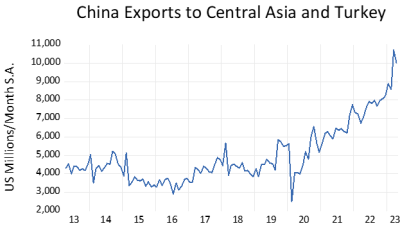
China’s exports to the five Central Asian countries represented at the Xi’an summit meeting last week soared this year, reaching a monthly rate of US$10 billion, nearly triple the pre-COVID level. President Xi Jinping proposed a sweeping program of infrastructure investments including energy pipelines and rail links as well as security cooperation.
The increase in trade dwarfs the $3.8 billion in direct aid that China promised during the conference.
China has economic as well as security concerns in the region. Central Asia specialist Wan Qingson wrote on May 21 in the Chinese website Observer: “The situation in Afghanistan, a neighboring country, has deteriorated. Terrorist organizations such as the Ansarullah Jamaat Organization, Al Qaeda, and the ‘Islamic State of Khorasan Branch’ (ISK) that are active on the borders of Central Asian countries continue to conduct cross-border Infiltrate, organize drug trafficking, and launch multiple terrorist attacks. In April 2022, the terrorist organization ‘ISK’ launched an attack on a mosque on the Uta border; in May, the Gorno-Badakhshan Autonomous Prefecture on the eastern border of Tajikistan was also attacked by terrorists. These frequent internal and external conflicts and crises have profoundly affected the security and stability of Central Asian countries.”
China’s security architecture in the region depends on close relations with Turkey, whose President Recep Tayyip Erdogan is likely to win reelection in a May 28 runoff.
The United States is also offering aid to Central Asia, but in tiny amounts. The US announced $25 million in aid last September, and Secretary of State Anthony Blinken promised an additional $25 million during a February visit to the region.

